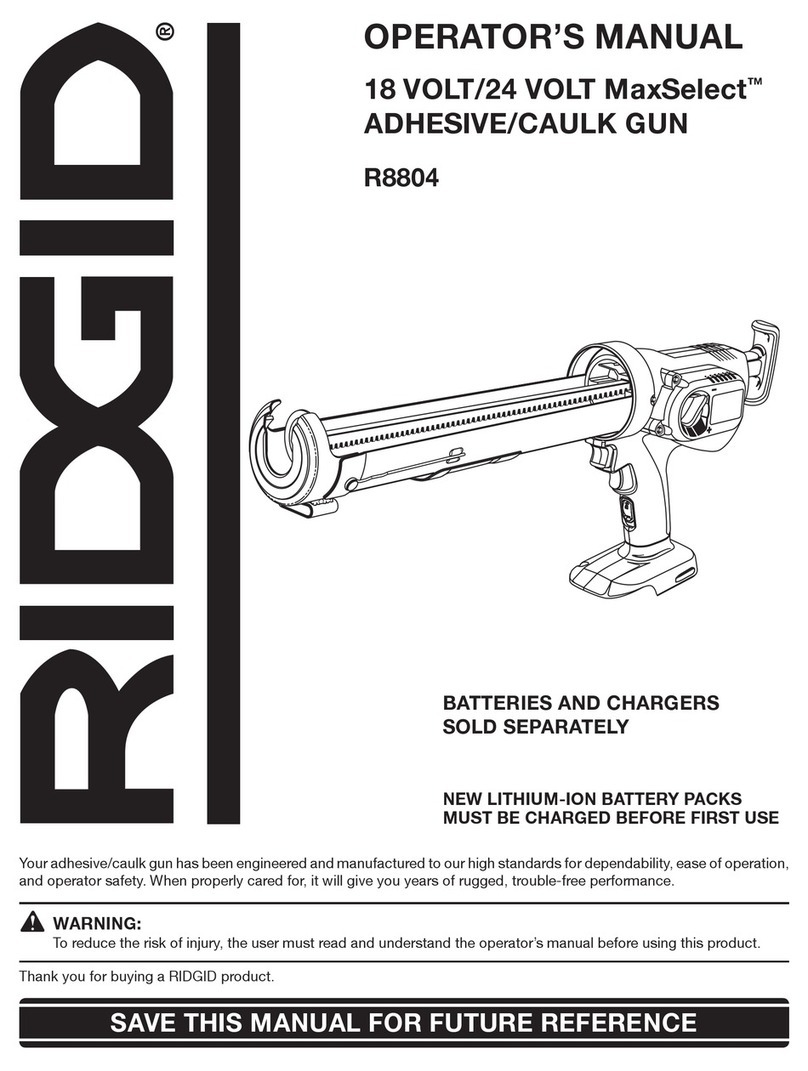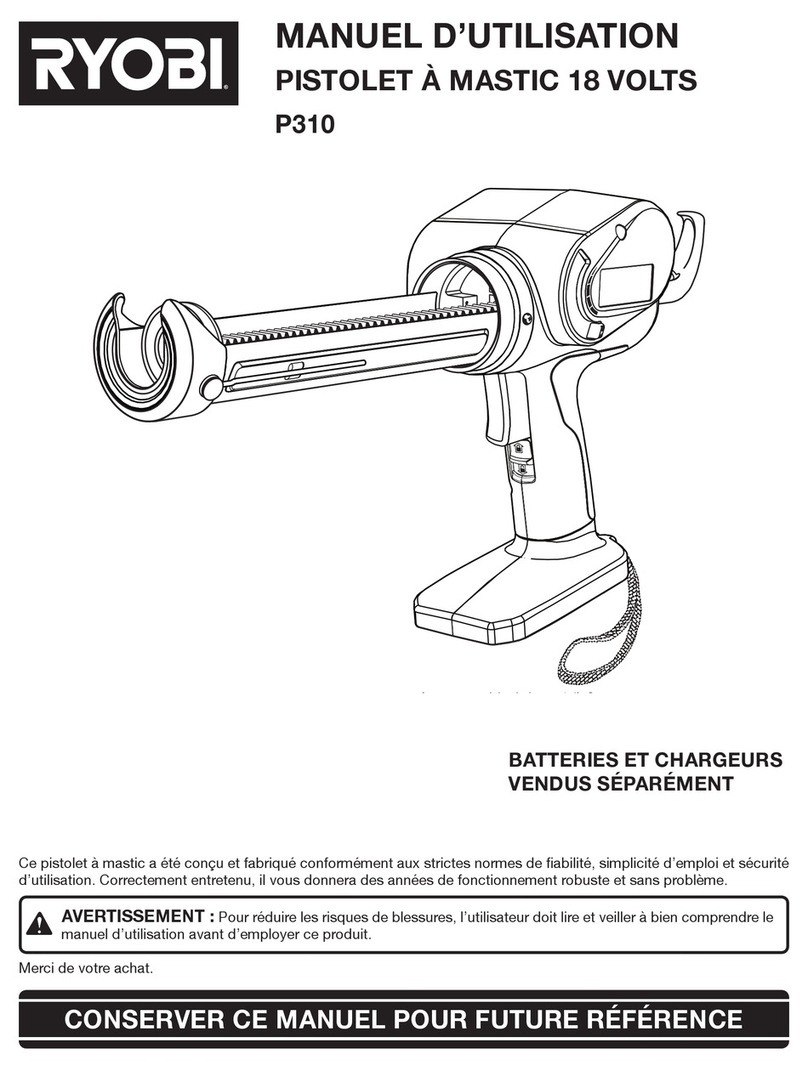Soraton HPS-4C2-10.8V Li-Ion User manual

Operating Instructions
PowerMax®
CORDLESS CAULKING GUN
Modell: HPS-4C2-10.8V Li-Ion
380ml to 410ml (5:1)Coaxial Cartridges

△
!WARNING
Operational Precautions
General Safety Instructions
1. Consider work area environment. Do not expose tools to rain. Do not use
tools in damp or wet locations:Keep work area clean and well lit. Do not use
tools in the present of flammable liquids or gases.
2. Guard against electric shock. Avoid body contact with earthed or grounded
surfaces.
3. Keep children away. Do not let visitors touch the tools or extension cord. All
visitors should be kept away from work area.
4. Store idle tools. When not in use, tool should be stored in a dry locked up
place, out of reach of children.
5. Do not force the tool. It will do the job better and safer at the rate for which it
was intended.
6. Stay alert. Watch out what you are doing:Use common sense. Do not operate
tool when you are tired. Check damaged parts. Before further use of the tool,
a guard or other part is damaged should be carefully checked to determine
that it will operate properly and perform its intended function.
7. Check for alignment of moving parts, blinding of moving parts, breakage of
parts, mounting and any other condition that may affect its operation.
8. A guard or other parts that is damaged should be properly repaired or
replaced by an authorized service center unless otherwise indicated in this
instruction manual. Have defective switches replaced by an authorized
service center. Do not use tool if switch does not turn it on.
9. To ensure the designed operational integrity of power tools, do not remove
installed cover or screws.
10.Use your tool at lower input than specified on the nameplate, otherwise, the
finish may be spoiled and working efficiency reduced by motor overload.
11.Do not wipe plastic parts with solvent. Solvents such as gasoline, thinner,
benzene, carbon tetrachloride, alcohol, ammonia and oil containing chloric
annex may damage and crack plastic parts. Do not wipe them with such
solvent. Wipe plastic parts with a soft cloth lightly dampened with soap water.
12.Dress properly. Do not wear loose clothing or jewelry. Contain long hair keep
your hair, clothing, and gloves away from moving parts.
13.Use safety equipment. Always wear eye protection, non-skid safety shoes,
hard hat, or hearing protection.
14.Do not overreach. Proper footing and balance enables better control of the
tool in unexpected situations.

Product Safety Instructions
1. Disconnect battery pack from tool or place the main switch in the locked or off
position before making any adjustments, changing accessories, or storing the
tool. Such preventative safety measures reduce the risk of starting the tool
accidentally.
2. Remove adjusting keys or wenches before turning the tool on . A wrench or a
key that is left attached to a rotating part of the tool may result in personal
injury.
3. Use clamps or other practical way to secure and support the work piece to a
stable platform. Holding the work by hand or against your body is unstable and
may lead to a loss of control.
4. Maintain tools with care. Keep cutting tools sharp and clean. Properly
maintained tools, with sharp cutting edges are less likely to bind and are easier
to control.
5. Use only accessories that are recommended by the manufacturer for your
model. Accessories that may be suitable for one tool may create a risk of injury
when used on another tool.
Important Safety Instructions for Charger & Battery Pack
1. Caution:To reduce risk of injury, charge only specific type rechargeable
battery packs. Other types of battery packs may burst causing personal injury
and damage.
2. Before using charger, read all instructions and cautionary markings on battery
packs and chargers.
3. Do not expose charger to rain or snow.
4. To reduce the risk of damage to electric plug and cord, pull by plug rather than
cord when disconnecting charger.
5. Use of an attachment not recommended or sold by the charger manufacture
may result in a risk of fire, electric shock, or injury to persons.
6. Make sure cord is located so that it will not be stepped on, tripped on, tripped
over, or otherwise subjected damage or stress.
7. Do not operate charger with damaged cord or plug. Replace them
immediately.
8. Do not operate charger if it has received a sharp blow, been dropped, or
otherwise damage in any way, take it to qualified center.
9. To reduce risk of electric shock, unplug charger from outlet before attempting
any maintenance or cleaning. Turning off controls will not reduce this risk.
10. Do not disassemble charger or battery pack, take it to a qualified service
center while repair is required. Incorrect reassembling may result in a risk of
electric shock or fire.
△
!WARNING
△
!WARNING

Additional Safety Rules for Charger & Battery Pack
1. Do not charge battery pack when temperature is below 10°C (50°F) or above
40°C (104°F).
2. Do not attempt to use a set-up transformer, an engine generator or DC power
receptacle.
3. Do not allow anything to cover or clog the charger vents.
4. Always cover the battery pack terminals with the battery pack cover when the
battery pack: is not used.
5. Do not short the battery pack.
6. Do not touch the terminals with any conductive material.
7. Avoid storing battery pack in a container with other metal objects
such as nails, coins, etc.
8. Do not expose battery pack to water or rain, A battery pack short can
use large current flow, overheating, possible burns and even a
breakdown.
9. Do not store the machine and battery pack in locations where the temperature
may reach or exceed 50°C (122°F)
10. Do not incinerate the battery pack even if it is severely damaged or
completely worn out. The battery pack can explode in a fire.
11. Be careful not drop, shake or strike battery pack.
12. Do not charge inside a box or container of any kind. The battery pack must be
placed in a well ventilated area during charging.
13. Do not leave batteries unused for extended period of time. Recharge the
battery every 3~6 months and bring Li-Ion battery to 40~80% charge level
before storage.
14. Li-Ion batteries are sensitive to high temperature and should be kept in a cool,
dry and out of direct light exposure. Ideal temperature for operation and
storage is below 77°F.
15. For extension of the battery lifetime, the lithium-ion battery is designed with the
protection function to stop the output.
In the case of described below, when using this product, even if you are pulling
the switch, the motor may stop.
This is not malfunction but the result of protection function.
When the battery power remaining runs out, the motor stops.
If the tool is overloaded, the motor may stop.
In this case, release the switch of tool and eliminate causes of overloading.
After that you can use it again.
If the battery is overheated under overload work, the battery power may
stop. In this case stop using the battery and let the battery cool. After that
you can use it again.
16. This product is designed with low voltage protection, which prevents the tool
from over discharging and prolong battery's lifespan.
△
!WARNING

Specific Safety Rules and/or Symbols
---------Recycle ------Class II Tool
---------Do Not Throw In Garbage V--------Volts
a.c.--------Alternating Current Hz-------Hertz
W----------Watts kg-------Kilograms
mm--------Millimeter d.c. -----Direct Current
kg-cm-----Kilograms Per Centimeter ft-lb------Foot-Pound
/min--------Revolutions or Reciprocations per Minute
Specifications
MODEL TYPE
PowerMax HPD-4C2-10.8V Li-Ion
VOLTAGE
10.8V d.c.
NO-LOAD SPEED
LOW:2 mm/s
HIGH:4 mm/s
EXPEL FORCE
550 kgf
TOOL WEIGHT
(Without Battery)
2.340 kg
(1.5Ah Battery 0.336kg)
CHARGING TIME
1 Hour Auto CUT-OFF
PERFORMANCE
20 TUBES OF 380ML CARTRIDGE FOR A FULLY
CHARGED BATTERYAT ROOM TEMPERATURE.
(1.5Ah)

View the Major Components
Accessory
Rack
Rear Knob
Rack Fixity
Rack
Plunger Disk
Compound Holder
Main Switch
Speed Control Dial
Battery Pack
Battery Knob
Charger
Belt
Fuel Gauge

Operating Instructions (Slide-In)
Installing or Removing Battery Pack
(See Fig.1 Fig.2)
1. Always switch off the machine before insertion or
removal of the battery pack.
2. To remove the battery pack, push the button on the
battery pack and pull the tool unit from the battery pack
in the direction.
3. To insert the battery pack, align the tool unit slides with
the battery pack sliding groove and push the tool unit
into place.
The tool unit can be slide into battery pack in two
directions.
4. Do not force the battery pack in sliding it into tool unit. If
the battery pack does not slide in easily, it is not being
inserted correctly.
Charging the Battery Pack (See Fig.3)
1. Plug the fast charger into the power source.
2. Slide the battery pack into the charger as the arrow
direction shown on the charger.
3. Push the battery pack into place and make sure the red
light on the charger is “ON”. The battery pack is now
starting the charging cycle.
4. After finish the charging cycle, the light will turn into
green. The battery pack is now ready for use.
5. Your new battery pack is not charged. You need to
charge it before use.
6. Always use the specified charger to charge the
battery. When the battery pack is inserted into the
charger correctly, the red light will come on and
charging will begin.
7. When you charge a new battery pack or a battery pack
which has not been used for a long period, it may not
accept a full charge. This is a normal condition and
does not indicate a problem. You can recharge the
battery pack fully after discharging it completely a
couple of times.
8. Unplug the charger from the power source after finish
the charge.
9. Please remove the battery from the unplugged charger
for storage.
Fig.1
Fig.2
1
2
1
Fig.3

LED Indication Function
The Battery Pack has a “SW” button and 4-step green LEDs for indicating
remaining capacity status and Over temperature condition.
The remaining capacity (RC) and temperature protection status green LED
indications ( 3 second ) when the “SW” button is momentarily pressed.
Remaining Capacity LED Indication
RC Status
LED 1 (green)
0%- 25%
LED 1, 2 (green)
26%-50%
LED 1, 2, 3 (green)
51%-75%
LED 1, 2, 3, 4 (green)
76%-100%
LED 1 Blinking (0.25Sec/green)
Fully Depleted
LED 1, 2, 3, 4 Blinking (0.5sec/ green)
Over Temperature condition

The LED Light on the Charger
Power On (Green light flashes slowly)
Battery Low (Red light stays illuminated)
Battery charged 80% (Green light flashes rapidly)
Battery charged 100% (Green light stays illuminated)
Battery Pack temperature is too hot or too cold (Red light flashes slowly)
Battery Pack malfunction (Red and Green lights stay illuminated)
△
!WARNING
1.Charger is plugged into a 110V-120V a.c outlet only.
2.If the battery pack is too hot or too cold, the charger will not fast charge the
battery pack and the red Indicator light is “blinking”. When the battery pack
temperature returns to between 0°C(32°F) and 50°C(122°F), The charger will
automatically begin charging.
3.If both red and green indicator lights are “ON” the battery pack either does not
comply or is defective. Please contact your retailer.
4.Do not charge the battery pack in the rain, snow or high temperature
environment.
5.Do not charge battery pack when environment temperature is below
0°C(32°F)or above 40°C(104°F)
6.While charge the cool battery pack (below 0°C) in the warm indoor, keep the
battery pack in the room for one hour to warm up before starting the battery
pack.
A cool battery may charge unsaturated.
7.Remove the plug after finishing the charge.
8.Do not use generator for charging the battery pack.

Tool Operation
1.Open the lid of the epoxy cartridge.
2.Screw the mixer tip to the epoxy cartridge.
3.Pull the Rear knob to extend rack, and put the cartridge into the epoxy gun.
4.Push the rear knob to have the disk slightly contact with cartridge to start
operating the epoxy gun.
5.Put one arm through the strap and hold the handle with your hand. Use the
other hand to hold the fixture.
6.Push main switch to start the epoxy gun.
7.The rack will retract slightly when you release the main switch in order to
prevent dripping, so allow a few seconds for the rack to move forward when you
press the main switch to operate.
8.The main switch located above the handle can be used to control speed.
Main Switch

IMPROTANT NOTES AND KEY FEATURES
1. Do not insert cartridge if it is wet, or if the sealing compound has hardened.
2. If the tool is operated for long period of time, the motor may overheat.
It is recommended to switch off from time to time.
3. Do not use flammable material, even for cleaning purposes.
4. When the rack is pulled to its initial position, do not press the switch and stop at
half way. This is to prevent the clutch from incomplete separation, which can
cause the body to hit and damage the mechanics.
5. Automated cut off function while the rack reaches its end.
6. The tool has a drip less function to keep epoxy from dripping. However, this
requires user to push the switch for more than 2 seconds to active this function.
MAINTENANCE
1. Make sure to remove the battery pack before starting maintenance work or
when checking the tool.
2. If epoxy sticks on the rack, it is necessary to pull the rack to its initial position to
get rid of the excess epoxy.
3. Clean the tool:
*Wipe the tool with a soft, dry cloth.
*Do not use a wet cloth or solvents. Since this may discolor the housing.
4. Inspect and clean the tool in regular. Internals.
5. Do not disassembly the tool. Should any repair become necessary, contact the
dealer where you bought the tool or consult an authorized service center.

!WARNING
To reduce the risk of chemical exposure due to over-pressurization of the cartridge
resulting in bursting:
Always wear appropriate eye, skin, and respiratory protection.
Always examine the cartridge prior to use. Do not use cartridge if there is
any visible damage to the cartridge and/or if the nozzle is plugged.
Always test for proper mixing and flow resistance by extruding a small
amount of material into an appropriate waste receptacle.
If material stops flowing from nozzle - release trigger pressure immediately!
Check to see if nozzle is plugged. If material does not resume flow, replace
cartridge.
Read, understand, and follow all recommendations in the cartridge MSDS
and label.
!WARNING
To reduce the risk of fire, explosion, and environmental contamination:
Do not dispose of lithium ion batteries by incineration or in regular trash.
Dispose of lithium batteries according to local, state, or federal regulations.
Table of contents




